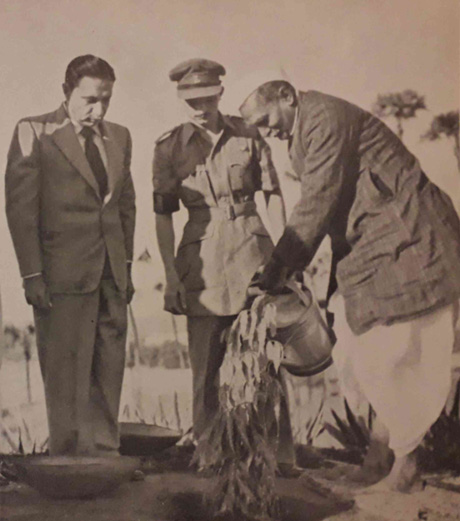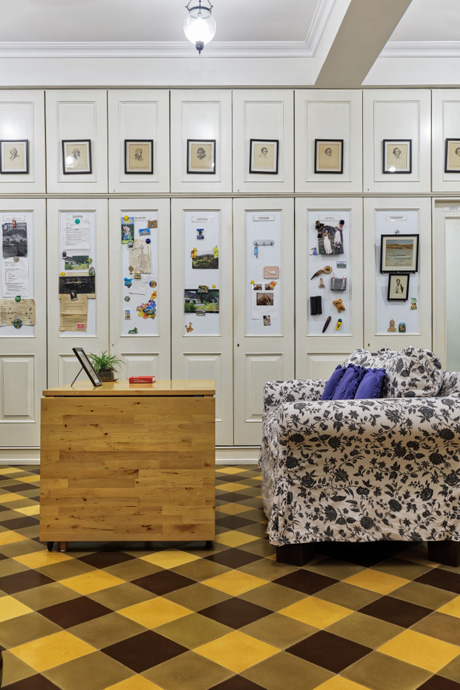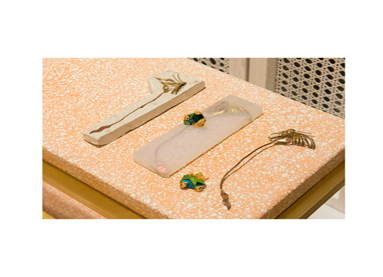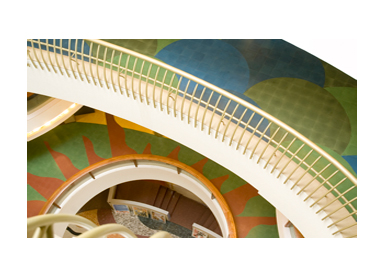100 Years
100 Stories


Patterned tiles at the Darbhanga Mansion, Mumbai, BFT Archives
It was 1946. Dara & Persis Khurody had moved to Darbhanga Mansion, Carmichael Road in Bombay from Delhi where the former had been with the Agricultural Marketing Department since 1935. During his tenure in Delhi, Dara, a life-long dairyman, had worked actively in developing the Agmark grading system and his work with the department was already legendary. However, it was his report of 1941 that was decidedly transformative. It was this report that laid the foundation for the Aarey Milk Scheme and brought Dara to the city as the Milk Commissioner of Bombay State.
The Aarey Milk Colony, built by him, with Bharat Tiles affixed firmly on the floors, was inaugurated in 1951. At the time of inauguration, an article in the Times of India comments that “The 12X12 tiles in a pleasant light blue add a beauty and charm rarely to be found in work of this kind and the tiles showed a departure from the usual dado work carried out in most buildings”. This, however, is not the story of Aarey Milk Colony, but of 12-A Darbhanga Mansion, the home of the Khurodys.
Darbhanga Mansion, the Bombay palace of the Maharaja of Darbhanga, had partly functioned as a hospital and a place for soldiers to recuperate during the Second World War. Once the war was over, the erstwhile palace was converted into apartments and sold to existing tenants, among others. Dara and Persis moved in at this time and were soon joined by their son, Nawshir. Darbhanga mansion, however, had been made for utility not aesthetics. Its limestone floors were basic to say the least and Nawshir, who had lived on Curzon Road in Delhi, found the dull interiors hard to cope with.
One day while trekking up the Duke’s Nose in Lonavala, Nawshir lamented to his fellow trekker, Dilnavaz Sidhwa, about the plain flooring in his house and how he wished he could get better tiles. Dilnavaz had the solution in a flash! Her father’s company produced the most beautiful tiles in a variety of colours and shades and Nawshir was sure to find something to his liking. That was it. All of Khurody's apartment was soon paved with Bharat’s tiles, and Nawshir claims that his favourites are the black and white chequered ones in his bedroom. Eventually, several apartments in Darbhanga came to be paved with the stunning colours of Bharat’s tiles.
Dara Khurody’s achievements brought him in contact with influential, talented people from across the globe. In 1963 Dara Khurody, along with Verghese Kurien and Tribhuwandas Patel, was presented with the Ramon Magsaysay Award for Community Leadership. The following year, the Government of India honoured Dara with the Padma Bhushan. During the 1950s to the 1970s, large parties were hosted by Dara and Persis Khurody at 12-A Darbhanga Mansions, with ballroom dancing after dinner. Due to his rank and position, several Heads of State and people of eminence and stature, from all over the world have dined and danced on Bharat’s floor tiles and admired them. Dara Khurody always entertained at home and rarely used restaurants. What indeed was the need for a rented space when your home made such a statement !
This legacy of entertaining and hosting glamorous parties continued to the next generation. Dara’s son and daughter-in-law, Nawshir and Roshan Khurody, have entertained the Vice-Chancellor of Cambridge University and Turkish Princesses on these same floors.
“I’m a vintage, heritage person by nature. I like everything restored to Victorian times. I would never change anything original”, says Khursheed Khurody. She is the third generation of her family to cherish the tiles. What’s more, when a neighbour was replacing their Bharat tiles, Khursheed salvaged those and installed them in a newly restored section of her home!
More recently, Khursheed has played several classical musical concerts on the piano to large audiences in the hall of Darbhanga Mansion and famous friends such as novelists Anita and Kiran Desai, Sir Leon Brittan, former Home Secretary of Britain and the former Director General Military Operations India, General Madan Gopal, have been hosted by the family on these floors.
However, it is not only their Mumbai home but even at their mountainous retreat that the Khurodys have had a Bharat connection. Belle Vue, is an 1859 estate which Khursheed inherited from her maternal grandparents the Kharegats. Here too, Bharat’s tiles have been laid in 2013, in the extension to the main bungalow, in an effort to match the hexagonal tiles of the rest of the bungalow. Khursheed took over the restoration of Belle Vue in 2011, and maintained its Victorian identity and integrity. Bharat Tiles made this restoration possible.
Bharat’s floors in 12-A, Darbhanga Mansion and the Belle Vue estate stand witness to a pioneering, talented, cultured family, its legacy and its enduring love for Bharat.






